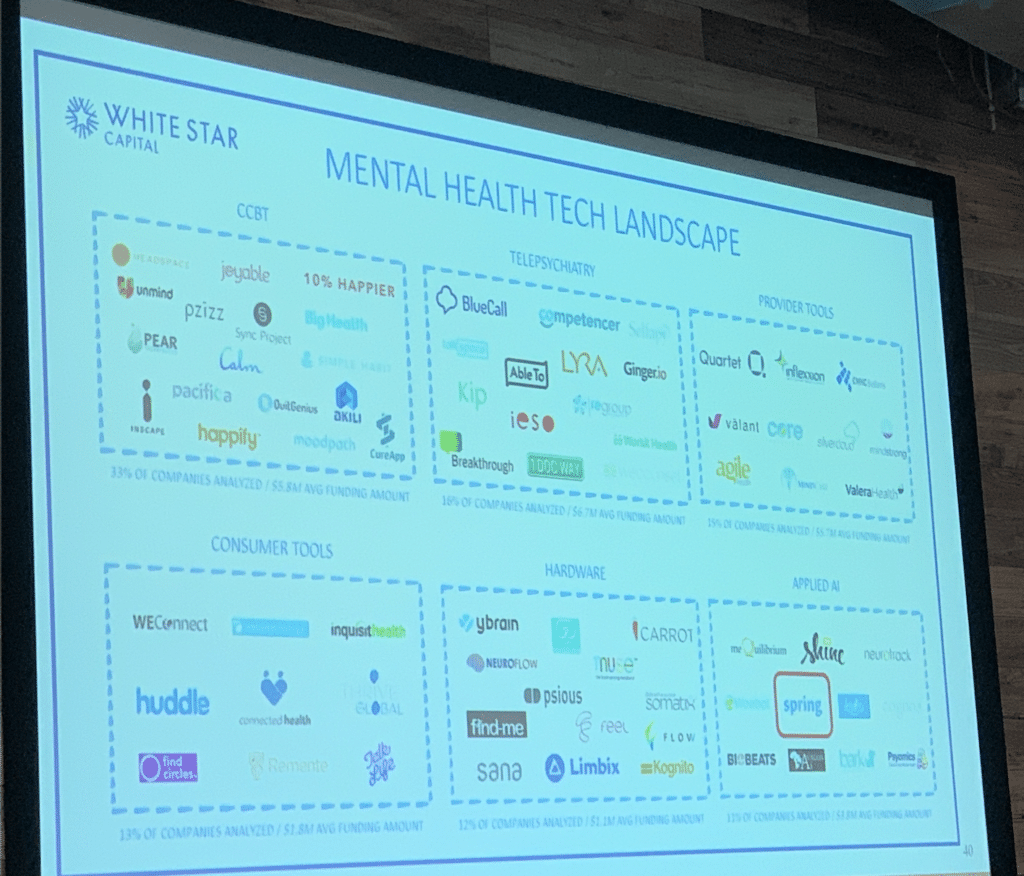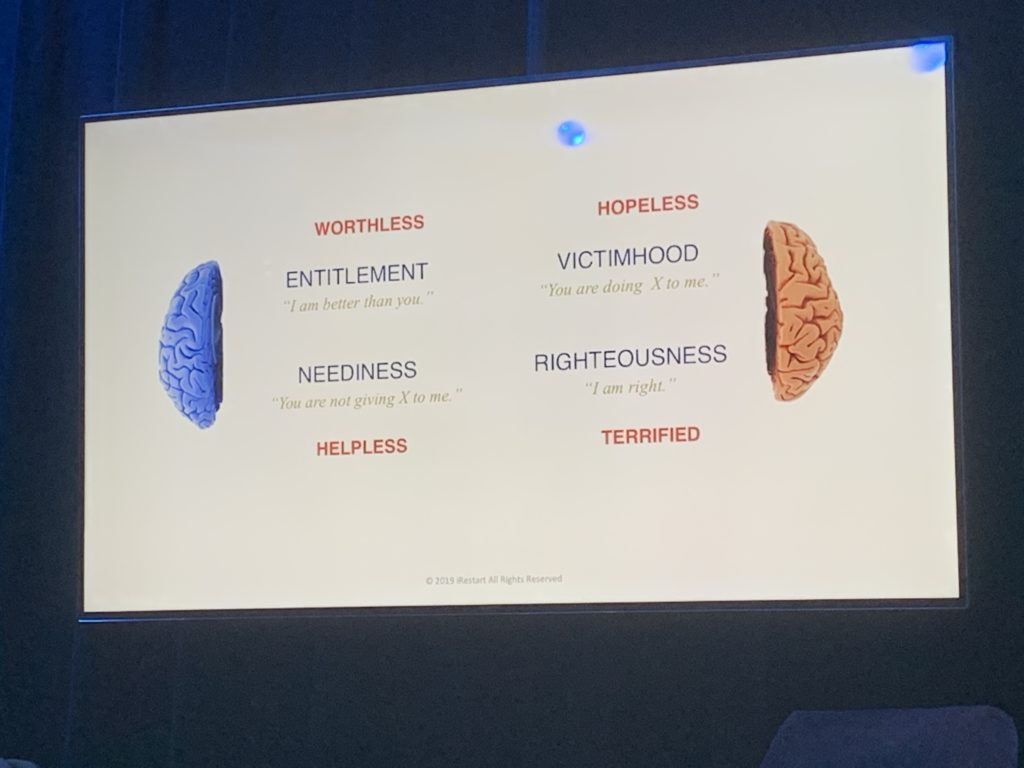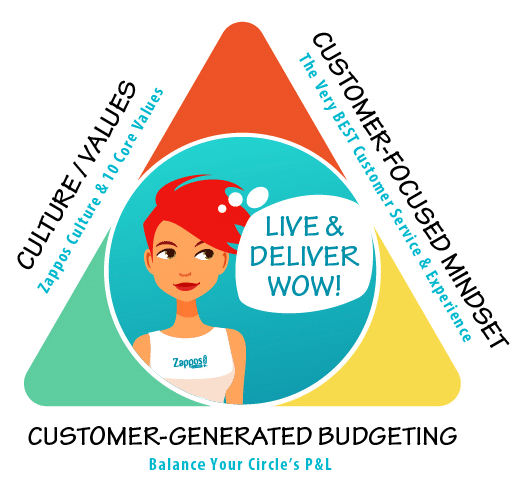

September 23, 2019
Great cultures
This is first time in years I returned to Zappos, this time for the Responsive Conference, perhaps the most cutting edge event on corporate culture that I know. Here are a few things I learned, through the lens of my own interests (not at all a comprehensive review).
Gary V has predicted that mental health will become a big issue for businesses to solve. I think it’s both stress on the rise, as well as more people openly sharing their challenges. David Hanrahan, VP of People and Places at Niantic, lead the session…
More ventures are developing apps to solve this (below).

Ernst and Young has developed strong mental health programs.
“The program – officially titled “r u ok?” – is an effort to end the stigma that surrounds mental health while connecting employees to existing resources within the organization. The program incorporates employee champions, cross-country presentations, virtual events, e-learning curriculums, peer-to-peer connections and follow-up services.
“The program has generated more than 49,000 touch points among US employees, including more than 23,000 articles read; 21,000 website hits; 1,000+ events attended; 781 e-learnings completed and more than 1,000 EY Assist consults.”
Rajkumari Neogi of iRestart gave a brilliant keynote on emotions and how they effect us. We all want to belong, but she makes the point that fitting in is actually the opposite of belonging. In order to fit in, we have to play to the mold. But if we want to feel belonging, then we want acceptance for what makes us unique, and that means being vulnerable.
She showed how typical troublemakers are actually suffering:
Bully – Feels worthless
Complainer – Feels hopeless
Caretaker – Feels Helpless
Micro Manager – Feels terrified.

And I’m particularly fascinated by her breakdown of the brain chemistry of our emotions:

It makes me wonder what causes what.
I’m currently working on my own brain chemistry right now, and especially intrigued by how GABA plays a role. Neogi is very excited by this as well. Having experimented with it in various forms, I believe the feeling GABA provides is one of feeling complete – in other words, the opposite of that feeling like we just can’t get enough done, and thinking about other things do to do, rather than being present. I asked her about it and we decided to meet up and continue the conversation.
If there’s a way to address this behaviorally, then I would say it’s this next part.
I was so surprised to see Mike Williams wearing a Zappos badge. Mike was the former COO for the David Allen Co (the author of Getting Things Done).
I met Mike several years ago at the Hacking Holacracy conference. He said that Holacracy basically blew up the company — It went from a 40 person sales, training, coaching and community company to a 7 person licensing company. I thought this sounded like a horror story up until I heard Brian Roberston (Holacracy founder) explain what happened at this conference. Through Holacracy they realized they’re world class at managing the brand and training trainers, so they licensed out everything else (such as sales) to those who are world class. Now they are reaching more people than ever.
For those of you who don’t me, GTD is like religion for me. It saves me from the chaos of my mind and all my ideas and tasks swirling all over the place. And I have often felt like the Prodigal Son, going far off the rails, only to come back and realize how powerful and peaceful this system is. I think as we have more and more distractions and more opportunities, a system like GTD is going to be so important. At Zappos I used to train people on how to get their Inbox to zero everyday and it was a game changer when people really got it.
So Mike is a king in this space, and co-authored GTD for Teens, which may actually be the best entry point for adults since the new revised GTD book is so dense. I was so happy to see Mike is now with Zappos, helping people get organized, and also offering it as a service to other companies through the Clarity program, which brings me to the next one…

This is where it gets the most exciting for me. When Tony first invited me to Zappos, my mandate was turn a cost center into a profit center. The company spent a lot of money on giving away free tours, sharing business advice and sending out free culture books. All of this added up to at least half a million dollars in time and materials. We developed Zappos Insights from a content company to an experience company and by the time I left we were close to 8 figures in revenue.
Now Tony’s genius has extended to making every cost center into a profit center. Each department has a P&L that works both internally and externally. They buy and sell services – for example, a department needs HR’s services so that department has to pay for it, but it in turn can charge other departments like Audio/Video offers its services as well. And the system works externally as well. For example, A/V was contracted to shoot a commercial for Nike.
How cool is that?
I think it started with a frustration (or “tension”) about budgeting. In Holacracy it’s top down by circle. And one person in the group can deny a request. So it just takes one “no” to kill an idea. Now with this system, it just takes one “yes” from a department willing to fund it.
For more information, see the Evolve Program and especially the Glossary.
Everyone knows about evaluation tools like the Meyers Briggs, and DiSC, but what about one based on Oxytocin. I was thrilled to see Doug Kirkpatrick there, who had a key role in Morningstar’s self-management program. He told me that they’re now focused on the “O Factor” from the book The Moral Molecule. It’s all about how trust is directly correlated with high oxytocin and the organizations that have higher oxytocin have more trust. I was quite surprised to hear about this, and more surprised that Morningstar is leading the way.
15Five, the feedback company, has been using a system called the Gene Keys to help people find themselves, as well as paying for a ticket for any employee who wants to go to Burning Man for the first time.
Responsive 2020 will be at Zappos again. I highly recommend going.
August 3, 2019
Great cultures ,Hacks
I’ve attended and run a lot of events over the years and the early ice breakers fascinate me because they have a power to open people up and connect and connect them. The first two I came up with, the last three are from the legendary Jack Canfield.
These are best done in small groups of 3-6, though it can also be done in a big group that’s less than 30 people.
1. What are you obsessed with?
This is great because it can be revealing and safe at the same time. You can share a deep fascination or simply the show you’re binging. People laugh a lot through this one and find points of connection they wouldn’t otherwise hear from people only sharing their home town, job and hobbies.
2. What are your pet peeves?
I love going negative because there’s energy there. Like the obsession question, you get to find out something interesting about people, and even what triggers them. It also has the potential to go deep (like causes people care about), or simple (such as people chewing loudly).
3. Sometimes I pretend to…
Now it gets funny. Where are you faking it? It starts out with answers like, “Sometimes I pretend I’m listening when I’ve really spaced out.” It’s great to keep going around for more than one answer. This question and the next ones are really best for smaller groups because it gets more and more vulnerable.
4. Sometimes I feel…
Each person says an emotion they experience that may surprise others. It can be just the emotion (sadness), or the emotion plus a context (Sometimes I feel sad when I’m at a party and I have no idea how to connect with people).
5. If you really knew me, you’d know I…
This is great because it can be about experiences or feelings that are current, or from one’s past. Again, it’s great to keep this going around for a few minutes because there’s a lot of richness there.
Closing
After these exercises you can close by having people go around and acknowledge each other. Just a couple minutes with that person in the center and everyone else chimes in (popcorn style) to say what they respect or like about that person.
You can experiment with these for your group, or even use them one-on-one to get to know someone better.
July 15, 2019
Uncategorized
This is a danger when you have too many priorities. It happens when the leaders believe and communicate that everything is important.
Because they create so many goals, people know that it’s simply impossible to reach them all at once, so they do one of two things:
The alternative is the Prime Directive.
What’s the one or two big things that will move the needle on everything else?
June 5, 2019
Productivity

You think it’s to Get Stuff Done, right? Wrong. That’s actually a by-product of a well-done system.
I’ve had to learn this the hard way, so hear me out…
First, basic systems theory states that the purpose of a system is not the design of a system. The purpose of a system is determined by its actual use and results.
The result of a to-do list is not actually getting things done because sometimes it happens and sometimes it doesn’t (am I right?)… BUT what is guaranteed from a well-structured system is a CLEAR VIEW OF THE TRUTH.
That means, a clear view of:
**What’s actually getting done.
**What’s getting stuck
**What you’re waiting on from other people
**What is getting neglected.
**What lingers for weeks and months
A great system shows you the truth in a fast snapshot. And then it’s your choice what you do with that truth.
Oddly, the result is peace, because it all becomes conscious. There’s no more “I forgot” no more “They never got back to me.” No more “What the heck did I even do this week?”
Do you have a system? “All change starts with the truth.” – Dan Sullivan